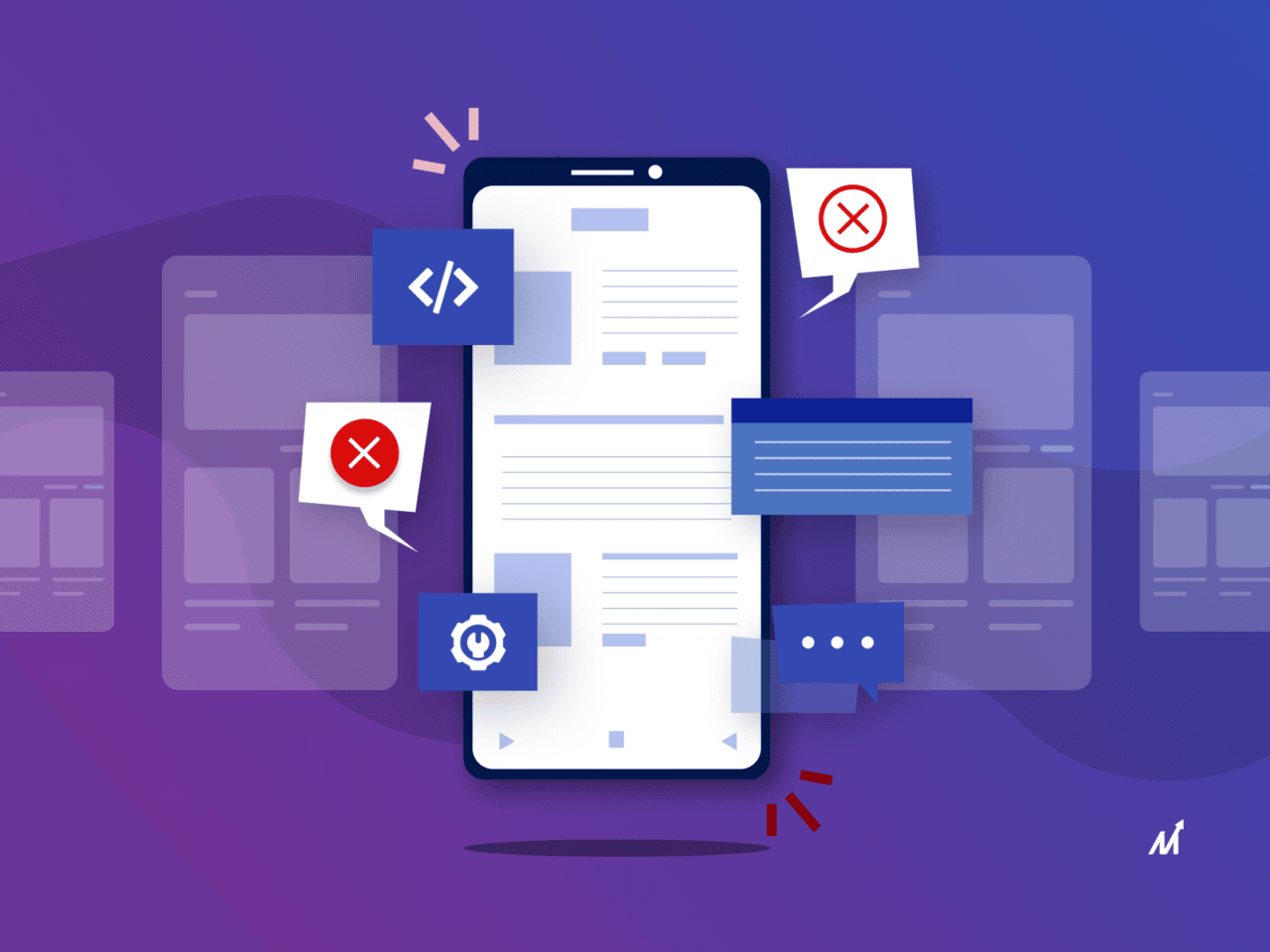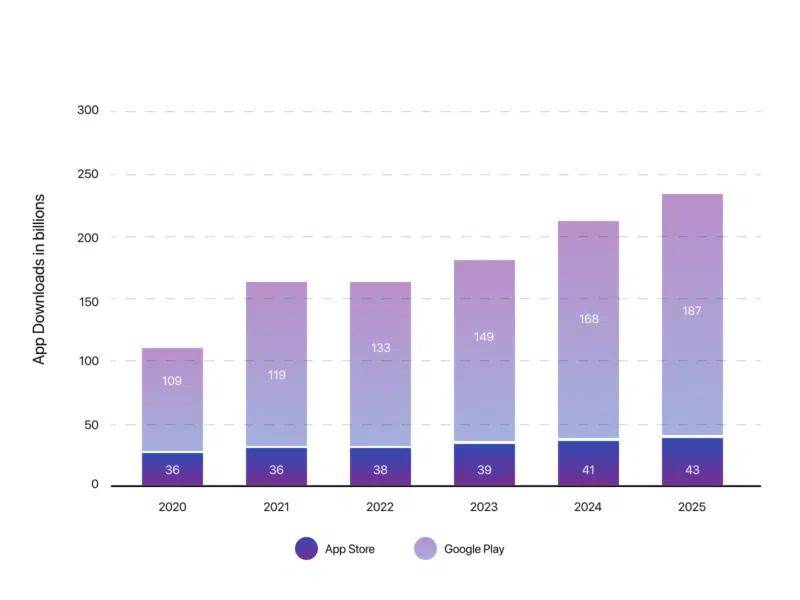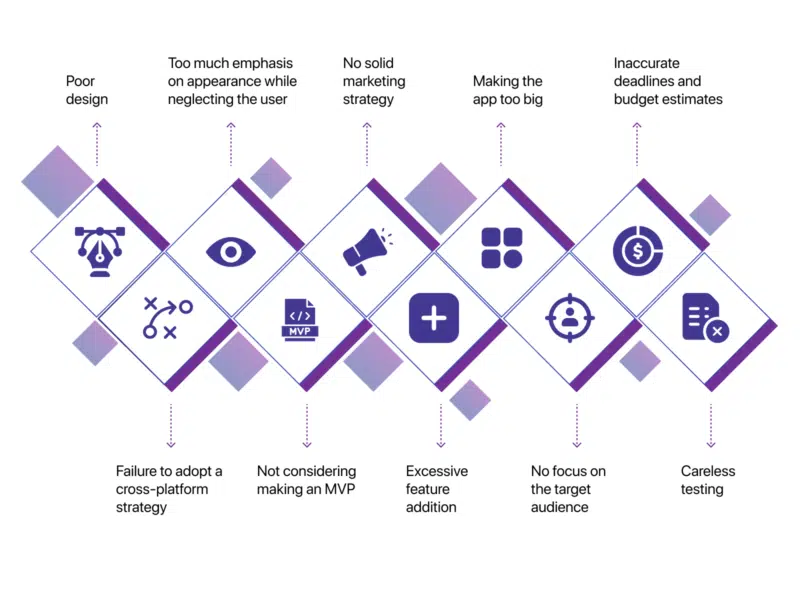Interactive mobile app development is no longer a difficult task, while perfection remains elusive. The tiniest error can cause significant problems and result in the loss of hard-earned money as well as valuable time. If you make mobile app development mistakes, you’ll pay ten times more for your efforts.
Any app development company’s primary goal is to ensure that they can spot apps that are likely to be underperforming. Those that fail to meet or exceed client expectations, resulting in dissatisfied or depressed clients.
The app development market is rapidly evolving and maturing. As a result, there are some excellent examples of high-performing apps and a profusion of low-performing apps.
On the other hand, the latter are frequently forgotten because they have no impact on consumers.
How many mobile apps do you think to have a possibility of succeeding?
Users will download 178 billion apps through the store by 2022. How many of them have a realistic probability of succeeding? According to Gartner, approximately 0.01%. This indicates that only one out of every 10,000 apps will be successful and well-known.
According to Geckoboard, around 75% of apps are removed within the first 90 days of being installed.
When considering a well-designed product, we must consider its users and requirements.
Mobile app developers are always trying to figure out why some apps fail. The most common justifications are as follows:
- An unsatisfactory user experience.
- Brand and product design have poor visual features.
- The app does not solve users’ problems.
Let’s delve deeper into why most mobile apps fail, what you can learn from them, and what frequent blunders you can now dodge at the outset of any project.
Further Read: Planning For Website Redesigning: Don’t Fall Prey To These 7 Crucial Mistakes
Common mobile app development mistakes to avoid in 2022
There are numerous aspects to consider while developing a mobile app. We’ve listed ten significant areas where a minor blunder can significantly impact your mobile app below.
1. Mobile app development mistakes: Poor design
Apps are frequently removed after their initial use. Their immediate disappearance is due to a poorly designed user interface (UI) and poor user experience (UX). A mobile app designer should mainly concentrate on designing a good UI to generate a pleasant UX in mobile apps.
The poor app design has limited room among mobile users, and nothing turns people off faster than an unintuitive design, a lousy interface, or a lack of features.
That isn’t to say that you shouldn’t employ images and animations to make your app appealing. Your app’s users will be confused if it has too many graphics. The design should be straightforward and intuitive.
Basic features like simple interfaces, uniformity between different panels, and CTA (Call to Action) designs can help you reach end-user expectations while designing your app’s UI.
2. Mobile app development mistakes: Failure to adopt a cross-platform strategy
Failing to build a viable cross-platform approach is another common blunder. The days of developing a mobile app for a single platform are long gone.
Developers may now create apps for both Android and iOS using powerful cross-platform mobile application development tools. Developers may distribute on different platforms using a single source code.
This is the list of some cross-platform mobile application development tools:
- Xamarin
- Flutter
- Ionic
- React Native
- Adobe PhoneGap
- Sencha
You can also use the cross-platform strategy to evaluate the market and determine whether to continue using the hybrid app or transition to a native app.
3. Mobile app development mistakes: Too much emphasis on appearance while neglecting the user
With a terrible user experience, even a great mobile app wouldn’t help. Rather than just focusing on the style of an app, you should keep your client’s needs in mind when designing it.
To engage and improve your consumer base, the user experience is critical. Keep the app’s design simple and fluid so users can easily navigate from one display to another. Instead of creating an app to serve only your company’s needs, create one that aids end-users.
Apps that accomplish the primary business goal while providing a great user experience can help you grow your business.
4. Mobile app development mistakes: No solid marketing strategy
Another reason why many mobile apps fail is because of this. It’s critical to effectively market an app before it goes live to increase the likelihood of people discovering it.
Companies frequently make the error of marketing their app after it has been posted on the app store. A successful app is promoted long before it is released. Divide your marketing strategy into three stages: pre-app, launch, and post-app.
Businesses with a social media presence should use these platforms to market and promote their new apps appropriately. You must optimize your program for Google Play Store and Windows Store8 to promote it successfully. Set your app’s title, keywords, descriptions, and screenshots so buyers can locate it quickly.
5. Mobile app development mistakes: Not considering making an MVP
Making an MVP could be the deciding factor in whether or not your app is a failure.
An MVP, or Minimum Viable Product, allows you to evaluate your app’s performance in real-world scenarios and with real-world users.
An MVP is a stage in the development process when your software has the essential functionality, allowing you to debut it in the market without having to go through the complete process at a high level.
Creating an MVP as a proof-of-concept saves time and money on the final product/app. You can expedite the development process by releasing a rudimentary version of your app, soliciting market input, making necessary model modifications, and improving the final product.
6. Mobile app development mistakes: Making the app too big
A digital consumer in the twenty-first century may be enthusiastic about a variety of things, but a huge mobile app is not one of them.
Unlike desktop computers, smartphones and other mobile devices have limited storage space. Unsurprisingly, most mobile device users avoid programs that take up a lot of space and slow down their devices.
As a result, minimizing the size of your app to the bare minimum should be a top focus.
7. Mobile app development mistakes: Excessive feature addition
Adding additional features is one of the most common mobile app development mistakes.
In fact, for many app developers and organizations, the term “feature-rich” has become a good trait, and app marketers use it frequently. Undoubtedly, this is one of app developers’ most frequently committed mobile app development mistakes.
On the other hand, having too many features in an app makes it burdensome and big without providing much value to the overall user experience, according to user feedback.
In contrast, a mobile app with fewer targeted functions is more meaningful and easy to grasp.
Furthermore, having too many features slows down the program and increases load time. Not to mention the time, effort, and resources invested in developing those new features.
In the case of an on-demand food delivery app, for example, the required functionality would be,
- Looking at restaurants and menus
- Address location detection
- Adding items to the shopping cart
- Payment
- Tracking of orders
- Help and support
These features will assist the user in resolving any issues with meal delivery.
8. Mobile app development mistakes: No focus on the target audience
Creating an interesting product isn’t enough. It needs to be targeted to the right audience. If you don’t know who your target audience is, your efforts will either result in the product failing in the market or, more often than not, in the greatly increased budget required for product development, promotion, and iteration.
A successful mobile app should continually strive to meet the needs of its target consumers. As a result, at the outset of mobile app development, it is critical to identify and assess the target audience’s characteristics.
9. Mobile app development mistakes: Inaccurate deadlines and budget estimates
To make an accurate estimate and set deadlines, the developer must extensively research the project and evaluate the specifics. This method is time-consuming. If you insist on an immediate project assessment, don’t be shocked if the budget and deadlines are multiplied during the app development process.
You should assume that creating a high-quality product takes a long time. When it comes to mobile apps, even under ideal conditions, the development period is usually three months, but it can be more.
10. Mobile app development mistakes: Careless testing
Testing is an essential phase in the creation of a mobile app. It is advised that testing be performed frequently. Using this method, you will have more opportunities to correct as many problems as possible. Regular testing requires time and effort, which is why some clients skip this stage, but this can lead to more serious problems later.
Every year, customers of mobile apps become accustomed to better product quality. The formerly acceptable quality level is now unacceptable, especially when it includes premium content or is delivered on a paid basis.
Conclusion
Creating a successful app is typically a lengthy and arduous process that takes place over several months.
Poor development processes include a lack of understanding of consumers’ demands, including too many stakeholders, and failing to consider user retention rates.
Get a top-notch mobile app developer with years of experience to create your business’s mobile app!
At Markovate, we provide a mobile app development service that builds high-quality and affordable applications for Android, iOS, and other platforms for industries like retail, travel, fintech, healthcare, and many more.









